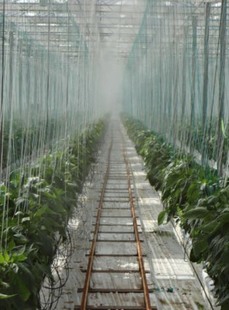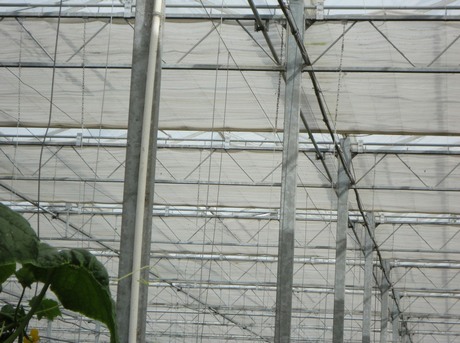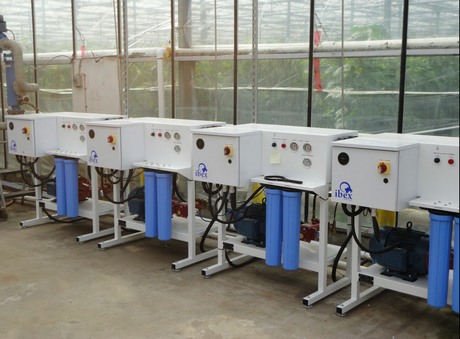 Installing a fog system inside your greenhouse can be a very useful tool to control the temperature and humidity. But what are crucial points when you install such a system and what can you expect when growing using a fog system. We asked Mark Stanley of MicroCool about the pros and cons on installing a high pressure fog system.
Installing a fog system inside your greenhouse can be a very useful tool to control the temperature and humidity. But what are crucial points when you install such a system and what can you expect when growing using a fog system. We asked Mark Stanley of MicroCool about the pros and cons on installing a high pressure fog system.Microcool notes a lot of interest by greenhouse growers for fog, cooling and humidification techniques. "Any greenhouse, wherever it is built in the world is dealing with peaks and troughs in temperature and humidity, and a fog system is increasingly becoming a favoured tool to help control the greenhouse climate", Stanley said. His company installs high pressure fog systems in greenhouses all over the world. "It's beneficial to install in any greenhouse, but how beneficial it is still depends on the location of the greenhouse and the nature of the crops . And of course the capabilities of the grower in terms of experience and knowledge are the biggest factor. You have to know what you are doing."
That the fog systems are welcome in many parts of the world is surprising. "We recently had an inquiry from a grower in Honduras. You would expect that he has enough, or maybe too much, humidity in the greenhouse and a fog system is not the first thing you'd think of. But they have issues when the humidity drops all of a sudden and the plants start to suffer in harsh conditions. Even in these climates a fog system can help to cool down the temperature in the greenhouse, a few degrees alone (3-4 degrees Celsius.) can make a big difference." With higher temperatures and drier air, the cooling is much higher.
MicroCool installs projects throughout the world, but the increasing demand for local, sustainable and safe food production in North America has brought them many projects. The larger greenhouse growers are building greenhouses in many states, fog systems helps them to cultivate a strong crop in the most difficult climates. "We installed a fog system for a greenhouse tomato grower in Las Vegas, who is able to keep a constant humidity, temperature inside the greenhouse, while outside temperatures are over 45 degrees Celsius. "
Fogging systems work on the principle of adiabatic cooling, explained Stanley. They create a fine fog by forcing pressurized water through a small nozzle. In the case of MicroCool's fogging system, the water pressure is around 70 bar with a nozzle orifice of 200 micrometers. The water pressure and size of the nozzle force out billions of water droplets that are 10 microns in diameter, or about one-tenth the diameter of a human hair. Because a smaller droplet has a larger surface area relative to volume, the droplets float in the air and evaporate quickly – much faster than larger water droplets that fall faster and take longer to evaporate. Through evaporative cooling, the greenhouse temperature drops. The smaller the droplet, the greater the cooling effect.

“To be most effective the water must flash-evaporate before it reaches the plant,” said Stanley, Vice President of MicroCool. “The lower the relative humidity inside the greenhouse, the faster the temperature will drop, so it's better to bring in dry air to keep the relative humidity down, because the degree to which you can cool the greenhouse gets lower when you have a higher relative humidity and the fog cannot flash evaporate as quickly.” In the past, not controlling the humidity and air quality inside the greenhouse made for lackluster performances from early fogging systems. But Stanley explained that advances in climate-control computers have vastly improved the performance of modern systems.

“Computers can selectively shut greenhouse vents to create low-pressure inside the greenhouse to draw in dry air at a high velocity at the same time that wet air is extracted,” explained Stanley. “That's why it's so important that our system works with a climate-control computer, otherwise you won’t get the right combination of factors necessary for effective cooling.” Early systems were also plagued with nozzles clogged by minerals in the water, but that problem has also been addressed in modern setups.
Over the past few years MicroCool has designed and installed high pressure fog systems for any kind of operation, from a grower on the Bahamas, to Ball State University and an organic greenhouse grower in British Columbia. MicroCool can help you with setting up a fog systems that fits your operation. Not every greenhouse or situation is the same, and each project requires an individual design in order to create the best result.

According to Stanley, all greenhouse structures can benefit from the use of a high pressure system when it is correctly controlled. "Large vegetable ranges and small research facilities use the systems to help maintain the correct growing environment. Each greenhouse is its own special case; depending on the size and height, the ventilation, the crop and the geographical location. MicroCool uses climate data to try to predict what is possible and also when it is NOT possible."
Economic Solution
But a system is installed, what is the pay back rate? "For us to calculate a ROI is a dangerous game", said Stanley. "It's the grower that is “driving”/operating the system, when he uses the system as a tool to extend his control over the climate, its all-in his hands. We can only supply the grower with a solution to help provided a perfect growing environment in the greenhouse, it's still in his hands what he does with this at the end of the day."
Contact Mark Stanley for more information:
MicroCool
Mark Stanley
+1-760-834-3345
mark.stanley@microcool.com
www.microcool.com
